The PPE you must have when doing massage during COVID-19 are (1) a good mask and (2) a face shield to reduce your risk of getting COVID-19 and/or infecting others.
If you’re only doing one, it’s time to up your game.
Last week, two clients cancelled because of sickness and a third cancelled because a family member tested positive for COVID. This week another client cancelled because of a fever.
I’m not claiming to be the bellwether of the COVID 2nd wave, but this cluster of data points in my work-life makes complete sense in the context of a country (US) whose infection rate and positivity rates are soaring.
It’s decision making time: Are you going to shutter your office for a few months or are you going to work through this COVID 2nd wave (as long as you can)?
If you choose to do massage as long as you can through the 2nd wave, it’s imperative that you keep yourself as safe as possible by not straying from protocol.
“Straying from protocol” was said for my benefit.
Why?
Because as this pandemic drags on, fatigue has set in and I find myself wanting to cut corners.
The client was only in the waiting room for 30 seconds, do I really need to wipe the coffee table down again?
Do I really need to get another disinfectant wipe to do that massage stool because this one is drying out?
Do I really need to wash my cloth mask that I use in between clients for tomorrow?
Yes.
Yes.
And YES!
This is not just the time to be vigilant. It’s the time to be HYPER-vigilant.
I have extra incentive to be hyper-vigilant. My wife, Lisa, had COVID in April. If you thought there were only two options with COVID—living or dying—there’s actually one more option: living with COVID after-effects that may or may not go away. They call this group of people who have not fully recovered from COVID-19 long haulers.
Lisa is a long hauler. Her long-hauler issues have improved, but they haven’t disappeared and she is starting month seven post-COVID diagnosis. In addition, there are cases of COVID-19 re-infection. In other words, once you have COVID, immunity is not guaranteed.
So, I desperately don’t want her to get COVID-19 again.
And that’s the extra reason why I’m going out of my way to protect myself in the massage room.
By the way, the measures I take to protect myself, act as protection for my clients, too.
If you don’t get COVID-19, you can’t give it (through airborne transmission).
So, looking out for yourself is a 100% win/win for you and your client.
Before we get into the exact details of protecting yourself, I want to give you a mental framework to work within so that you can make the best decisions regarding your safety and your clients’ safety.
The framework is this: Act as if your client has COVID-19.
The Mental Framework for Staying Safe
This is what happens in my brain when I start with that premise.
If my client has COVID-19 would I walk back into the massage room she just came out of without a face shield on?
No.
If my client has COVID-19 would I take my mask off in the office after the he has left?
No.
If my client has COVID-19 would I work in a room with poor air exchange?
No.
Raising your level of vigilance may be raising your blood pressure, too, but if you take action and follow strict safety protocols, your brain should feel some sense of relief, knowing that you’re doing everything humanly possible to stay safe, and subsequently keeping your client safe, during a massage.
Alright, now let’s talk about essential PPE and two PPE related items that protect me and my clients at the same time.
Massage Therapy PPE
Here’s the PPE:
- Masks
- Face shields
Here are the PPE-related items:
- Air exchange
- Viral load
Masks
I’m starting with masks because it makes the most sense when I talk about protecting myself from getting infected.
COVID-19 is an airborne illness. The first place to stop COVID-19 from enter my lungs and going into my bloodstream are at the holes where air comes in, nostrils and mouth.
A mask keeps the COVID -19 virus out and if you have it, it can help keep the COVID-19 virus in.
A good mask does a better job at keeping COVID in or out than an average mask.
Recently the CDC stated the importance of a mask in protecting the wearer. And there has been compelling examples from the beginning of this pandemic that masks protect the wearers like this one: In July of 2020 two hair stylists in Sprinfield, Missouri tested positive for Covid-19 after interacting with 139 clients and 6 coworkers.
Here’s the important thing: No one they interacted with was known to get Covid-19.
How did that happen?
Most experts think it was because both the hair stylists, fellow employees and customers wore masks.
Studies bolstered this conclusion.
Can you say mask up?
And that means everybody—no client exceptions.
At our office we have disposable medical masks that we offer the client who have forgotten to bring a mask or whose mask is too uncomfortable to wear face down.
For the one or two clients who can’t breathe through any mask face down, we do the open pillow case over the face cradle so that the client is breathing into the open pillow case.
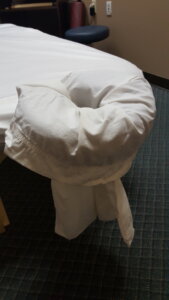
So, we agree that universal mask wearing in the massage room is a must, right?
Now the question is which type of mask should you use?
Pick Your Mask Using The Best Information
Which is the best mask for preventing droplet transmission?
According to a Duke study, the N95.
The N95 is a “respiratory protective device designed to achieve a very close facial fit and very efficient filtration of airborne particles.” (Source: FDA).
Also, effective for blocking droplet transmission are 3-ply surgical masks (“a loose-fitting, disposable device that creates a physical barrier between the mouth and nose of the wearer and potential contaminants in the immediate environment”, Source: FDA) and cotton masks.
Not effective and possibly worse than wearing no mask were thin, polyester neck gaiters. You can read more about that here.
Here are some suggestions to test see if your current mask is up to snuff: If you hold the mask up to the light and can see through it, get another mask. Or if you can easily blow threw it, turn the mask into a finger puppet.
Personally, in the massage room, I wear a N95 with a disposable medical mask on the outside of the N95. After each massage I change out the disposable medical mask, but keep the same N95 on through the course of the day.
And I don’t throw out the N95 after one use. Instead, I reuse it by rotating it back into my PPE gear after a three day air-out period.
So, that means I have three to four N95s I rotate out throughout the week, depending on how many days I’m working.
I air-out each N95 that I’m going to reuse in a paper bag instead of a plastic bag to cut down on moisture which could be a breeding ground for bacteria.
Where do you get N95s?
So, where can you get N95s?
My advice is do NOT buy them off Amazon.
Why?
Because there are counterfeits circulating on the Amazon website–and, personally, I don’t want to risk having a N95 that is faulty.
So, to find a N95 that is National Institute for Occupational Safety and Health (NIOSH) certified as a N95 respirator (filters at least 95% of airborne particles) and/or is FDA cleared as surgical mask (liquid resistant) takes a little research.
Start your research here: NIOSH – Approved N95 Particulate Filtering Facepiece Respirators.
In this list you’ll find approved manufacturers and their products.
After you choose a manufacturer/product, you’ll contact them to get in touch with one of their official distributors.
My N95 Search
My research turned up the FDA-approved Makrite 9500-N95 Pre-Formed Cone Particulate Cone Particulate Respirator Mask. It’s both NIOSH certified and FDA cleared as surgical mask (the surgical mask liquid-resistant-clearance is less important for us because we usually don’t slip in a little open heart surgery during our relaxation massage).
Once I found the approved manufacturer I wanted to go with, I Googled them and then contacted them through their contact form.
From there, they put me in touch with an official distributor of their products.
Yes, this is more complicated than simply clicking on an Amazon link, but, again, that easy click yields a world of unnecessary risk in my book–and I don’t want that extra worry that comes with that risk during this 2nd wave.
By the way, the price I paid for N95s through an official distributor of an FDA-approved manufacturer was within the price range of the unofficial distributors on Amazon, which was about $4/mask. (Remember, that a box of 20 for $80-ish will last you a two to three months if you reuse them on a rotating basis.)
I’m going to tell you the N95 manufacturer I went with, but before I do that I want to let you know that I am NOT an affiliate marketer of their products and or receive any compensation from them.
So, after searching for a NIOSH certified and FDA-approved N95 mask, I went with the 9500-N95 made by Makerite. The manufacturing company, Makerite, was very responsive.
They put me in touch with this distributor: SPH Medical Supplies.
Tony from SPH got back to me and was very informative and helpful. Ultimately, I purchased the Makerite 9500 N95 and the Sekura N95 also made by Makerite.
The 9500 N95 is both a surgical mask (resistant to fluids) and a respirator.
The Sekura N95 is not a surgical mask, but is a respirator. Again, respirator meets our working requirements–surgical mask is above and beyond.
I ordered the Sekura N95 because it’s supposed to be more comfortable than the 9500 N95.
One more thing to say about getting your N95s: If you hate dealing with the research and have a client or know someone in the medical field, contact that person. She/he may let you order PPE through her/his organization.
* Below are Amazon affiliate links. As an Amazon Associate I earn from qualifying purchases.
3 Layer Surgical and Cloth Masks
If you don’t have the budget for N95s, you still have options. Three-ply surgical masks and certain cloth masks did well in the Duke Study.
3-Layer Surgical Face Masks
Cloth Masks
Here are plain, old standard 2-ply cotton masks:
Okay, time to talk about face shields.
Face Shields
Wait, we already covered the mouth and nose to reduce the possible transmission of COVID-19 through droplets via coughing or sneezing. Why the eyes now?
From an article in Managed Healthcare Executive:
“The eyes are an important part of the body to protect because, like the nose and mouth, they are mucous membranes where germs can infect the body,” Ruchman says. “The virus spreads when infected droplets from a sick person’s mouth or nose come in contact with another person’s face, often when they cough, sneeze or talk. Although it’s more likely to be infected by inhaling these droplets through your mouth or nose, they can also enter through your eyes, especially if you touch something that has viral particles on it and then rub your eyes.”
Still not ready to look like a chem lab tech or a HAZMAT 1st responder?
According to an NPR article, Dr. Joseph Fair, virologist and epidemiologist, believes that he caught coronavirus through the eyes. On a crowded flight he wore a mask and gloves, but no eye protection. Two weeks later he had COVID-19.
The CDC also acknowledges that transmission could happen through the eyes.
Dr. Abraar Karan at Harvard Medical School says, “it’s hard to quantify exactly what the risk is in terms [of] through the eye specifically.” (NPR article.)
And even though Karan and other experts feel that eye transmission is less likely than nose or mouth, Karan goes on to say in the article that “…in health care settings, eye coverings are immensely important. ‘We definitely don’t go into [coronavirus patients’] rooms without eye coverings.’ He says other jobs that require people to work face-to-face, like a barber, might also choose to wear a full-face clear plastic shield.”
More Reasons To Wear a Face Shield
And let’s add this to our particular mix: In order to do our job, we break almost every COVID-19 no-no.
We are in a enclosed area with a person for a protracted period of time where we can’t social distance.
In fact, even though the client is wearing a mask (if you still have reservations of insisting clients wear masks during a massage, go here now), we are often within feet of the client’s nose or mouth.
Guess what? I’m wearing a face shield.
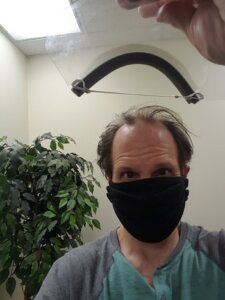
What You Need to Know About Face Shields
According to the CDC, a face shield should cover your forehead, go below your chin and wrap around the sides of your face.
Here’s the good news about face shields: They are inexpensive and easy to clean.
I purchased my face shield on Amazon.
Experts recommend soapy warm water so that you don’t destroy the anti-fogging coating if it has one. I use disinfectant wipes because my shield is cheap and it’s more convenient for me to clean that way.
At this point, you may be ready to ditch your mask in lieu of a shield. But that is not what the experts want you to do.
They are saying add the shield as a supplement to the mask.
Why?
There is not enough research to determine if shields alone are as effective as masks for protecting against COVID-19 transmission.
Eyes, nose and mouth protected? Check.
One more thing: air exchange.
Air Exchange in the Massage Room
Wait, that’s not PPE, Mark.
You’re right, but it’s part of the protecting yourself from the airborne transmission of COVID-19.
Plain and simple: You want lots of air exchange in your massage room.
Why?
If a client has COVID-19, you ultimately don’t want to breathe in any virus particles.
Assume you’re wearing an N95. That’s good, but it’s an N95, not an N100, right? So, some particles are getting in and at some point you might be breathing in COVID-19 air.
Fresh air coming into the room and stale air going out helps with diluting the room air or getting the potential virus out of the room.
How do you get good air exchange in your massage room?
Just open a window and if you’re space allows it and your client is comfortable with it, open the massage room door, too.
Since we now space our clients out, I can confidently assure the client that no one will be coming into the office while she is on the table. And I haven’t had a client object to the massage room door being open or partially open. In fact, most seem to think it is a good idea. I’m guessing they don’t want to be breathing in “stale” (COVID) air either.
Remember when I said one more thing? I lied. I have one more thing regarding my one more thing.
It’s viral load.
Viral Load
If a client comes into your office and has COVID-19 but is asymptomatic and you have an N95 on and a window and a door open, you’re still probably not going to be able to dodge each COVID-19 particle in the room.
BUT if you reduce the amount of exposure time to COVID-19, you could be reducing the viral load, the amount of virus that gets into your bloodstream, and that could just be the ticket to getting a low-grade infection instead of a severe infection.
So, how do you minimize potential viral load?
By minimizing how much potential COVID-19 air you breathe in.
Masks help with that.
So does opening a window and a door by “diluting” the air.
An air purifier may reduce viral load by killing the virus, but they are expensive.
The good news is that there’s something super-inexpensive, in fact free, that you can do to potentially reduce viral load.
It’s work COVID-19 smart.
Work COVID-19 Smart
Did you ever see demonstrations of someone talking or sneezing with a standard cotton mask on? The area of droplet spray is around the edges of the mask, especially around the nose where there tends to be bigger gaps between the material and the face.
Think about that when your client is face up or even face down on the table. Where do you want to be in relation to droplet flow? Not above the nose, right?
This is a challenge for me because I love doing supine neck and face work. But since COVID-19 mask demonstrations I realized that the above-the-head position not only puts me close to the clients face, but also aligns me with where the biggest gaps in the face mask are.
So here’s how I’ve adapted to spend less time in the potential COVID-19 exposure zone. I…
(1) do less work at the head of the table by working from the shoulders.
(2) spend less time working at the head of the table in general, 1 – 3 minutes at time.
(3) have the client not talk when working at the head of the table.
(4) use a fan to blow client exhalation away when I’m at the head of the table (yet to try).
(5) turn off any heating or cooling device that is blowing the clients exhalation towards me while I’m at the head of the table working.
(6) work up and down a body instead of side to side so that I can break up the amount of time that I’m close to the client’s face.
(7) let my room air-out after the massage.
(8) rotate between two massage rooms.
(9) wear all PPE, N95 and face shield, when cleaning the room in case there still may be aerosolized COVID-19 particles in the room.
The idea here is to not to drive yourself crazy; it’s to give yourself ways to reduce your potential exposure time to the virus so that you don’t get sick (or die), become a long-hauler or spread the virus and subject others to the virus’s wrath.
Vow to Be Hyper-Vigilant Until COVID-19 Is Under Control
Who would have thought that being self-centered, protecting yourself to the hilt, turns out to be best thing you can do to protect your client, too.
But it is.
Now that the pandemic is raging again, we need to shake off the battle fatigue and double-down on protecting ourselves.
And don’t cheap it.
That was inner-dialogue that got out because right now I’m thinking about my PPE and cleaning/disinfecting costs and wondering how I can save money.
Forget it, Mark.
Get the N95 that will keep the COVID out.
Use as many wipes as you need to disinfect the face cradle to reduce contact transmission.
Go ahead and use a disposable medical mask over top your N95 for each massage.
This is not forever and letting your guard down could cause a whole lot of hurt for you, your loved ones, your clients and people you don’t even know.
Mask up.
Face shield up.
Create decent air exchange in your room.
Reduce potential viral load.
Clean and disinfect like you’ve never cleaned and disinfected before.
We’ll get through this by protecting ourselves and never taking our eye off the ball until it’s safe to do so.
My Email Group
Want to get my latest info? Sign up for my email group. It’s free.

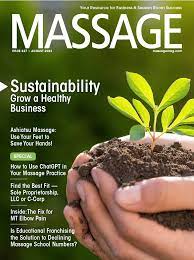
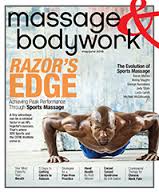
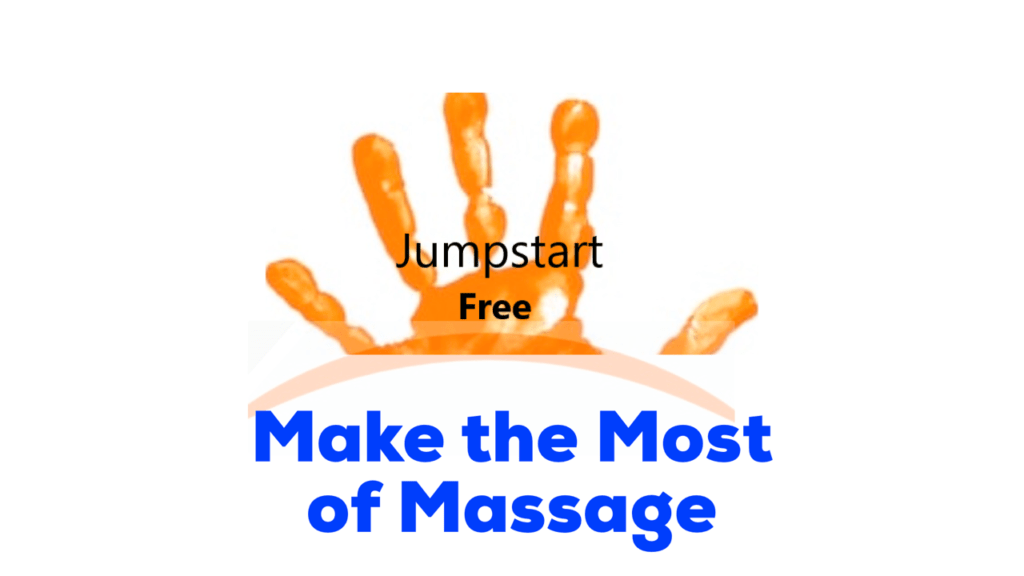
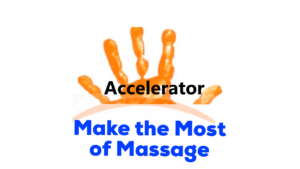
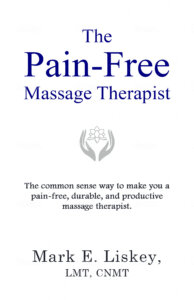
Comments on this entry are closed.
Hey Mark, I agree with everything you say. I want to add about keeping your immune system bolstered by taking Vitamin D3, Vitamin C, and Zinc supplements. I also take Cod Liver Oil and B complex also. That keeps me healthy and I recommend them to my clients especially now.
TakeCare,
Carol xXx
Hey, Carol! Good point about keeping your immune system bolstered with vitamins and supplements. I need to work on cooking more meals and getting more sleep, too! Thanks for reminding me about the other part of staying healthy during COVID-19.